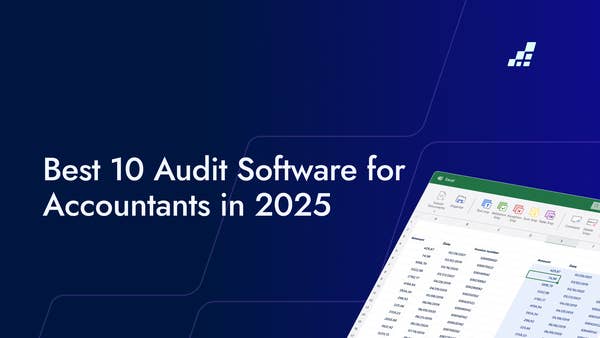- /
- Blog
Automating Audit Walkthroughs: Unlocking Efficiency and Accuracy

That being said, manual walkthroughs can be a pain in the you-know-what. They’re time-consuming, resource-intensive, and prone to errors.
Today, firms are increasingly turning to automation to streamline their audit procedures.
In this article, we will explore the benefits of automating audit walkthroughs and discuss key considerations before adopting automation.
What are walkthroughs in audit?
First things first, what are walkthroughs in audit?
Walkthroughs provide auditors with an opportunity to obtain evidence and assess the effectiveness of internal controls, making them an essential part of the audit process.
During a walkthrough, auditors meticulously analyze the flow of transactions within an organization. They start by selecting a specific transaction and then follow its path from initiation to completion.
This process allows auditors to gain a comprehensive understanding of the organization's internal controls and procedures.
Audit Walkthrough Documentation
As auditors trace the transaction, they document each step and control mechanism in place.
This audit walkthrough documentation includes details about the individuals involved in each stage of the transaction, the specific actions taken, and the controls implemented to ensure accuracy and completeness.
By documenting these controls, auditors can evaluate their effectiveness and identify any potential weaknesses or gaps.
Audit Walkthrough Interviews
During a walkthrough, auditors may also conduct interviews with employees involved in the transaction process.
These interviews allow auditors to gain insights into the employees' understanding of the controls in place and their adherence to established procedures.
Additionally, auditors can address any concerns or questions raised by employees during these interviews, further enhancing the effectiveness of the audit process.
Audit Walkthroughs in a Nutshell
By thoroughly examining the internal controls and procedures, auditors can identify any potential errors, misstatements, or fraudulent activities.
This helps in mitigating risks and providing stakeholders with confidence in the organization's financial reporting.
Through this comprehensive examination, walkthroughs contribute to the overall integrity and transparency of the audit process.
What is the Purpose of a Walkthrough in Audit?
The purpose of an audit walkthrough is to understand the client's internal controls and evaluate their effectiveness in preventing errors, fraud, and other financial irregularities.
By conducting walkthroughs, auditors can verify the accuracy of financial statements and identify any control deficiencies or weaknesses that may impact the client's financial reporting.
The Issues with Manual Audit Walkthroughs
While manual walkthroughs have been the traditional approach, they come with several challenges.
- Time-Consuming and Resource-Intensive: Auditors physically navigating through the client's systems and processes slows down the audit process and limits the number of walkthroughs possible within a timeframe, potentially hampering comprehensive coverage of essential areas.
- Prone to Human Errors and Biases: Auditors may overlook critical control points, leading to incomplete assessments of the client's internal controls. Misinterpreting the effectiveness of certain controls also risks inaccurate audit conclusions. Plus, modern business complexity further increases error likelihood.
- Limited Scalability: Manual walkthroughs have limited scalability, especially with multiple clients or large organizations. Ensuring consistency and standardization becomes progressively difficult, compromising audit quality and comparability of findings across engagements.
The Significance of Automation in Audit Walkthroughs
Automation has brought about a significant transformation in the field of auditing.
Through the integration of automation in audit walkthroughs, organizations can achieve improved efficiency and accuracy. Automation enables the collection of data and execution of tests on a larger scale and at a faster pace compared to traditional manual methods.
As a result, auditors can allocate more attention to value-added tasks like data analysis and risk assessment. Embracing automation empowers auditors to work more effectively.
Furthermore, automation helps mitigate the potential for human errors and biases, ensuring consistent and reliable outcomes. With clearly defined workflows, automation reduces the risk of overlooking critical control points, ultimately enhancing the overall quality of audits.
The Significance of Technology in Audit Walkthroughs
Automation has brought about a significant transformation in the field of auditing.
Through the integration of automation in audit walkthroughs, organizations can achieve improved efficiency and accuracy. Automation enables the collection of data and execution of tests on a larger scale and at a faster pace compared to traditional manual methods.
As a result, auditors can allocate more attention to value-added tasks like data analysis and risk assessment. Embracing automation empowers auditors to work more effectively.
Furthermore, automation helps mitigate the potential for human errors and biases, ensuring consistent and reliable outcomes. With clearly defined workflows, automation reduces the risk of overlooking critical control points, ultimately enhancing the overall quality of audits.
The Role of Technology in Audit Walkthroughs
Automation can be effectively applied to various aspects of audit walkthroughs. One instance is the collection and validation of data from different sources. Automation facilitates the extraction of data from client systems, performing necessary calculations, and validating the accuracy and completeness of the gathered information.
Automation can also generate comprehensive documentation and audit trails, ensuring transparency and accountability throughout the audit process. This documentation serves as valuable evidence and supports effective communication with clients and regulatory authorities.
Key Considerations Before Adopting Automation
Before implementing automation in audit walkthroughs, accounting firms need to consider several factors.
- Assess internal process maturity and readiness for automation: First, evaluate the current audit methodology and identify automation opportunities.
- Evaluate scalability and compatibility of existing systems: Second, check if current systems can integrate with automation technology.
- Address data privacy and security concerns: And finally, ensure compliance with industry standards and regulations for handling sensitive client information. Implement measures to protect against data breaches.
Implementing Automation in Audit Walkthroughs in your firm
When introducing automation in audit walkthroughs, it is crucial to have a well-defined strategy and roadmap.
- Identify processes for automation and assess their impact on audit quality and efficiency: Start by identifying suitable audit processes that can be automated. Evaluate how automation can positively affect the quality and efficiency of the audit.
- Develop a robust governance framework for monitoring and controlling automated walkthroughs: Establish a strong governance structure to oversee the automated audit process. Assign specific responsibilities and create guidelines for handling exceptions or errors that may arise during automation.
- Promote collaboration between auditors, IT professionals, and process owners: This collaborative effort will help address technical challenges, provide guidance on system integration, and ensure that the automation solution aligns with the firm's overall audit strategy.
By following these steps, the firm can successfully implement automation in its audit processes, leading to improved efficiency and audit quality, while effectively managing exceptions and ensuring alignment with the firm's strategic goals.
Automating Audit Walkthroughs with DataSnipper
Learn how to efficiently document your walkthrough audit procedure with DataSnipper's Snips and Smart Search.


